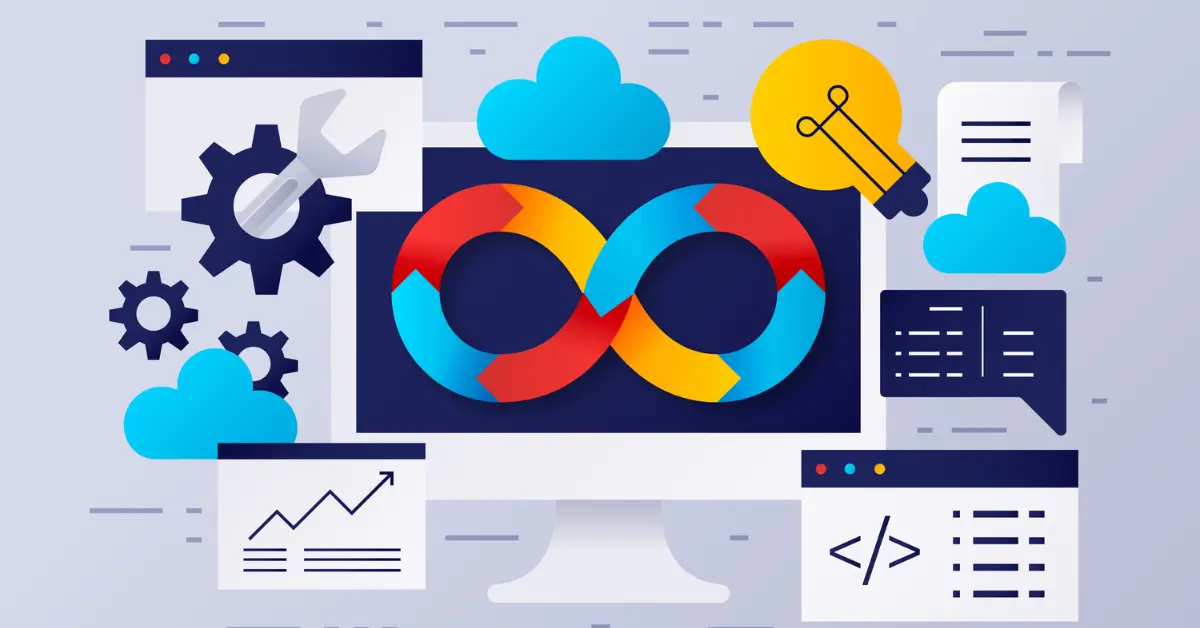In today’s fast-paced tech landscape, businesses need to deliver software faster, more reliably, and with fewer errors.
Enter DevOps—a transformative approach that bridges development (Dev) and operations (Ops) to revolutionize how teams build, test, and deploy software.
But what exactly is DevOps, and why has it become a cornerstone of modern IT? Let’s dive in.
Introduction to DevOps
What Is DevOps, and Why Is It Important?
DevOps is a cultural and technical movement that emphasizes collaboration, automation, and continuous improvement between software developers and IT operations teams.
Unlike traditional methods where these teams worked in silos, DevOps fosters a shared responsibility model, enabling organizations to deliver high-quality software at unprecedented speed.
Why it matters:
- Accelerates time-to-market for new features.
- Reduces deployment failures and rollbacks.
- Enhances collaboration and breaks down organizational silos.
- Improves scalability and system reliability.
How Does DevOps Differ from Traditional IT Operations?
Traditional IT operations often involve manual processes, slow communication, and reactive problem-solving. DevOps, however, prioritizes:
- Automation: Scripting repetitive tasks (e.g., testing, deployments).
- Proactive Monitoring: Identifying issues before they impact users.
- Continuous Feedback: Developers and operations teams iterate together.
The Evolution of DevOps
The term “DevOps” emerged around 2009, popularized by thought leaders like Patrick Debois and Andrew Clay Shafer.
It evolved from Agile methodologies, which focused on iterative development but lacked integration with operations.
DevOps filled this gap by emphasizing end-to-end ownership of the software lifecycle.
Core Principles of DevOps
- Collaboration: Shared goals between Dev and Ops.
- Automation: Streamline workflows (CI/CD pipelines).
- Continuous Improvement: Learn from failures via retrospectives.
- Customer-Centric Action: Prioritize user feedback in updates.
How DevOps Works
The DevOps Pipeline: From Code to Deployment
A DevOps pipeline automates the software delivery process. Here’s how it works:
- Plan: Define requirements and track progress (tools: Jira, Trello).
- Code: Developers write code in collaborative environments (Git, GitHub).
- Build: Compile code into executable files (Maven, Gradle).
- Test: Automated testing for bugs and performance (Selenium, Junit).
- Deploy: Release to production using orchestration tools (Kubernetes, Ansible).
- Operate & Monitor: Track performance and user behavior (Prometheus, New Relic).
- Feedback: Gather insights to refine the next cycle.
Key Stages of the DevOps Lifecycle
- Continuous Integration (CI): Merge code changes frequently.
- Continuous Delivery (CD): Automate deployments to staging environments.
- Continuous Deployment: Automatically release to production after passing tests.
Speed and Efficiency Gains
By automating manual tasks and enabling smaller, incremental updates, DevOps reduces deployment times from weeks to hours. For example, Netflix deploys thousands of times daily using DevOps practices.
DevOps vs Other Methodologies
DevOps vs Agile: What’s the Difference?
- Agile: Focuses on iterative development and customer feedback but stops at the deployment phase.
- DevOps: Extends Agile principles to operations, ensuring seamless delivery and monitoring.
Can They Work Together? Absolutely! Agile-DevOps integration (often called “DevOps Agile”) combines rapid development with reliable operations.
DevOps vs CI/CD
CI/CD (Continuous Integration/Continuous Delivery) is a subset of DevOps. While CI/CD automates testing and deployment, DevOps encompasses broader cultural and operational shifts.
DevOps Roles and Career Opportunities
What Does a DevOps Engineer Do?
A DevOps engineer acts as a bridge between developers and operations, managing tools, automating workflows, and ensuring system reliability.
Key Responsibilities:
- Designing CI/CD pipelines.
- Managing cloud infrastructure (AWS, Azure).
- Implementing monitoring and logging solutions.
Skills Required
- Proficiency in scripting (Python, Bash).
- Knowledge of IaC (Infrastructure as Code) tools like Terraform.
- Expertise in containerization (Docker, Kubernetes).
Top DevOps Certifications
- AWS Certified DevOps Engineer
- Docker Certified Associate
- Certified Kubernetes Administrator (CKA)
DevOps Tools and Technologies
Essential DevOps Tools
- Version Control: Git
- CI/CD: Jenkins, GitLab CI
- Configuration Management: Ansible, Chef
- Monitoring: Grafana, Datadog
Role of Kubernetes in DevOps
Kubernetes automates container orchestration, enabling scalable, resilient deployments—a perfect fit for DevOps workflows.
DevOps Benefits and Challenges
Benefits for Businesses
- Faster innovation cycles.
- 63% fewer deployment failures (DORA 2021 Report).
- Cost savings through efficient resource use.
Challenges
- Cultural resistance to collaboration.
- Complexity in toolchain integration.
DevSecOps: Integrating Security
DevSecOps embeds security into the DevOps pipeline, ensuring vulnerabilities are caught early.
The Future of DevOps
AI and Automation
AI-driven tools will predict system failures and optimize resource allocation. For example, AI-powered testing bots could auto-fix code errors.
Evolving Trends
- Serverless architectures reducing infrastructure management.
- Increased adoption of GitOps for declarative infrastructure.
FAQ:
Yes! DevOps engineers often possess a strong foundation in scripting (Python, Bash), cloud platforms (AWS, Azure), and automation—skills that are highly transferable to data science. For instance, experience with infrastructure-as-code (IaC) tools like Terraform can help in managing data pipelines, while expertise in monitoring tools like Prometheus aligns with data analysis tasks. To transition, focus on learning data-specific skills such as machine learning frameworks (TensorFlow, PyTorch), statistical analysis, and tools like SQL or Apache Spark. Many DevOps engineers successfully move into roles like Data Engineer or ML Ops Engineer, where their operational expertise complements data-driven workflows.
No—DevOps and Agile are complementary methodologies. Agile focuses on iterative software development, collaboration between cross-functional teams, and delivering customer value in short sprints. DevOps extends these principles by integrating operations (deployment, monitoring, maintenance) into the cycle, ensuring rapid and reliable delivery. For example, while Agile teams might release a feature in two weeks, DevOps ensures that the feature is seamlessly deployed, monitored, and optimized post-launch. Together, they form a “DevOps Agile” culture that balances speed with stability.
Not at all. Startups and small-to-medium businesses (SMBs) benefit significantly from DevOps practices. For smaller teams, DevOps automation reduces manual workloads, enabling faster scaling without hiring large IT teams. Tools like Docker and Jenkins are cost-effective and simplify CI/CD pipelines, even for smaller projects. For example, a startup using AWS and Terraform can automate infrastructure scaling based on user demand, ensuring they only pay for what they use. DevOps levels the playing field, allowing smaller companies to compete with enterprises in terms of deployment speed and innovation.
DevOps integrates security into the software lifecycle through DevSecOps, a practice that embeds security checks into every stage of the pipeline. For instance, automated tools like SonarQube scan code for vulnerabilities during development, while Clair checks container images for risks before deployment. Security teams collaborate with developers from the start, ensuring compliance (e.g., GDPR, HIPAA) is baked into the design. This “shift-left” approach reduces breaches and minimizes the cost of fixing vulnerabilities, as issues are caught early rather than post-deployment.
Cultural resistance is often the biggest hurdle. DevOps requires breaking down silos between development, operations, and even non-technical teams like marketing or finance. For example, legacy organizations might struggle with developers unwilling to take on operational tasks or ops teams fearing job loss due to automation. Successful adoption requires leadership buy-in, training programs, and incremental changes—like starting with a pilot team to demonstrate DevOps benefits (e.g., faster deployments, fewer outages). Tools alone won’t work without a collaborative mindset.
Unlikely. While AI and machine learning are transforming DevOps—through predictive analytics, automated incident response, or self-healing systems—human oversight remains critical. AI can alert teams about a potential server overload, but engineers design the architecture and troubleshoot edge cases. For example, AWS’s DevOps Guru uses AI to flag anomalies, but engineers interpret these insights to optimize systems. Future roles may evolve to focus more on strategic tasks (e.g., AI model training, workflow design) rather than routine automation.
It varies based on company size and existing processes. A small team might adopt basic CI/CD pipelines in 3–6 months, while enterprises could take 1–2 years for a full transformation. Start by automating one workflow (e.g., testing) and gradually expand. For example, a mid-sized company might:
Month 1–3: Implement Git for version control and Jenkins for CI.
Month 4–6: Introduce monitoring with Prometheus/Grafana.
Month 7–12: Adopt Kubernetes for orchestration and train teams on DevOps principles.
Continuous improvement is key—DevOps is a journey, not a one-time project.
Yes, especially for career advancement. Certifications validate your skills to employers and provide structured learning. For example:
AWS Certified DevOps Engineer: Demonstrates cloud automation expertise.
Certified Kubernetes Administrator (CKA): Essential for container orchestration roles.
Azure DevOps Engineer Expert: Ideal for Microsoft-centric environments.
However, pair certifications with hands-on practice. Employers value real-world experience with tools like Ansible or Terraform more than theory alone.
SRE is a subset of DevOps focused specifically on reliability and scalability. While DevOps emphasizes collaboration and end-to-end ownership, SREs use software engineering to solve operational problems. For example, an SRE might write code to automate incident response or ensure 99.99% uptime for a service. DevOps engineers, on the other hand, often handle broader tasks like CI/CD pipeline design. Both roles share goals but differ in specialization—think of SRE as “DevOps with a reliability-first mindset.”
Conclusion
DevOps isn’t just a set of tools—it’s a mindset shift that empowers teams to innovate fearlessly.
By fostering collaboration, automation, and continuous learning, DevOps ensures businesses stay competitive in the digital age.
Whether you’re a developer, IT pro, or business leader, embracing DevOps is key to unlocking agility and resilience.





